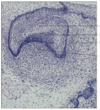QUIZ 2 Tooth Development Flashcards
(70 cards)
what are two examples of patterning defects of human dentition?
tooth agenesis (absence of teeth) and cleidocranial dysplasia (development of 3rd layer of teeth)
what is the paradigm for organogenesis? (tooth morphogenesis)
- positional information - where they need to be
- shape determination
- size variance
- cell proliferation and migration
- terminal differentiation
- specialized matrix foramtion
- programmed cell death
all organs develop from ___ and ___ layers
epithelium and mesenchymal
what guides organogenesis?
epithelial-mesenchymal interactions
cell communication is mediated by ___
signaling molecules
growth factors turn on transcription factors, which control which 3 things in development?
proliferation, differentiation, and apoptosis
what is the difference between autocrine and intracrine signaling?
- autocrine signaling involves the cell releasing a factor that has an affect on itself
- intracrine involves the cell producing a factor that affects itself, but never actually leaves the cell first
___ interactions are critical in development
cell-cell
___ interactions dictate morphogenesis and differentiation
cell-matrix
what does the cranial neural crest give rise to?
- ganglia and nerves
- adrenal medulla
- ectomesenchyme of bones and teeth
- dentin
- bone
- cementum
- periodontal ligament
what is developed by 37 days in utero?
- stomatodeum or primitive mouth
- covered by primitive epithelium
- embryonic connective tissue also referred to as ectomesenchyme
describe the dental lamina
- becomes the future tooth bud
- outer primary epithelial band
- ectomesenchyme below (cells are more loosely packed)
- meckel’s cartilage within ectomesenchyme

cell proliferation at the dental lamina causes ___
thickening
label this photo


what are the six stages of crown development?
- initiation - induction
- bud stage - proliferation
- cap stage - proliferation, differentiation, morphogenesis
- bell stage - proliferation, differentiation, morphogenesis
- apposition stage - induction and proliferation
- maturation stage - maturation
what are the structures formed in the initiation stage?
lamina and bud
what are the structures formed in the morphogenesis stage?
cap and early bell
what is the structure formed in the cell terminal differentiation stage?
late bell
what structures are formed in the matrix synthesis stage?
dentin, enamel, and cementum/bone
what stage of development is the tooth type (incisor, premolar, molar, etc.) determined?
morphogenesis stage (cap, early bell)
proliferation of epithelium produces buds at how many locations along each dental lamina?
10
each bud is the precursor of the ___ for each deciduous tooth
enamel organ
at the bud stage, ___ acts along with ___, ___, and ___ to stimulate the mesenchyme to express transcription factors ___, ___, ___, and the ECM molecules ___ and ___, and more ___
- at the bud stage, BMP-4 acts along with Fgf-8, Lef-1, and shh to stimulate the mesenchyme to express transcription factors, Msx-1, Msx-2, early growth response-1 (Egr-1), and the ECM molecules syndecan and tenascin and more BMP-4.
what is induction?
the process where one tissue changes the development of surrounding tissues


























